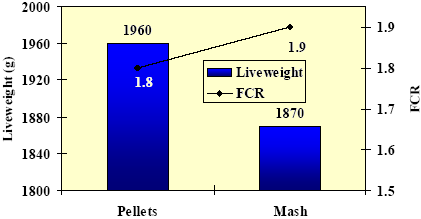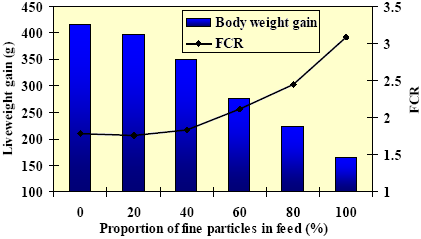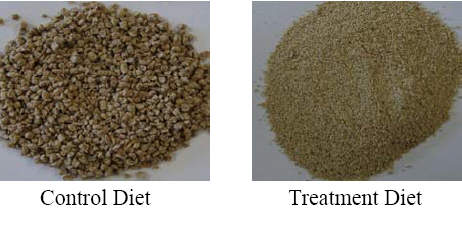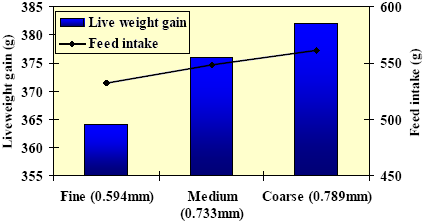



Influence Of Feed Form On Broiler Performance
By Aviagen - Good broiler growth rates will be achieved if the daily nutritional requirement of the bird is met. The ability of the bird to achieve its daily nutritional requirement will, in part, depend upon the nutrient composition of the diet; however what the bird actually responds to is feed or nutrient intake.
For good broiler growth and efficient nutrient utilization it is therefore vital that a good feed intake is achieved. Feed intake can be significantly affected by feed form. A poor feed form will inhibit feed intake and have a negative impact on growth rate. It is important that both nutrient density and feed form are optimal if feed intake and bird performance are to be maximized.
Today’s broilers are generally fed diets which have been through the pelleting process. The pelleting of poultry rations improves weight gain and feed efficiency when compared with unprocessed mash diets (Fig. 1). This improvement in performance is partly due to increased feed intake. Birds fed pellets also use less energy for feeding; therefore the energy available for growth is increased.
 Fig. 1: Influence of feed form on 42 day broiler performance (Munt et al., 1995) |
This positive response is improved if the pellet is of good quality. A diet with good pellet quality has high pellet durability and a low level of fines. Durability is the pellets ability to remain intact during handling and transportation. Low durability results in breakdown and the accumulation of fine
particles in the feed. The accumulation of fine particles will give poorer growth and an increased FCR (Fig 2.). To maximize performance the accumulation of fine particles in the feed should be minimized.
 Fig. 2: Influence of fine particles in the feed on broiler performance (Quentin et al., 2004) |
Aviagen Field Trial
In this trial birds were fed a high quality wheat based control diet or a treatment in which this was roller milled to fines. This created two extremes as shown in Fig. 3. The diets were fed for a period of 10 days. At 10 days of age the liveweight of birds fed the treatment diet was, on average, 50g lower than that of birds fed the control diet (234g vs. 284g), and FCR was increased by 21 points (1.26 vs. 1.05). Thus feed form has a significant effect on early broiler performance leading to a reduced liveweight poorer FCR and a worse uniformity.
 Fig. 3: Diet types used in Aviagen Field Trial looking at the influence of feed form on early broiler performance |
Improving Feed Form
Feed form, in particular the accumulation of fine particles in the feed as a result of poor pellet quality, will have a negative impact on broiler performance. With field surveys reporting instances of birds receiving as little as 28–37% intact pellets, poor pellet quality is a significant barrier to achieving good broiler performance.
How could pellet quality be improved? Pellet quality is influenced by
- the raw materials of the diet
- dietary fat inclusion
- dietary particle size.
Raw Materials
Wheat and wheat by-products are good binders which produce a good pellet quality. Maize is a poor binders producing poor pellets. Pellet breakdown is greater in diets based on maize than in diets based on wheat. Adding wheat will help to improve pellet quality but may affect the flexibility of the least cost diet formulation.
Dietary Fat
The addition of more than 2% fat in the mixer has been shown to reduce pellet quality, particularly for maize based diets. However, the addition of fat post pelleting allows fat to be added to the diet without compromising pellet quality.
Particle Size
It is generally assumed that grinding raw materials to a finer particle size will improve pellet quality; however the scientific evidence for this is not clear. The potential benefits to pellet quality of grinding to a finer particle size must be balanced against the increased energy cost of the feed mill as a result of doing so. Where pellet quality is poor and pellet breakdown is likely to occur, grinding to a finer particle size will lead to the accumulation of fine particles in the feed which will have a negative impact on broiler performance.
The consumption of very fine feeds will result in an increased feed wastage and an increased energy cost of feeding, while the feeding of very coarse feeds may result in the intake of an imbalanced diet due to diet selection.
Birds prefer a coarser dietary particle size to a finer dietary particle size and this preference is associated with an increase in feed intake and an improvement in bird performance (Fig. 4).
 Fig. 4: Influence of particle size on broiler feed intake and live weight (7 – 21 days) (Nir et al., 1990) |
Where pellet quality is poor and pellet breakdown may occur it may therefore be beneficial for bird performance to use a coarser particle size. It may be better to feed a good quality coarse mash than a poor quality pellet which would break down to fine particles in the feed.
Uniformity of particle size is also important for bird performance. Diets with a uniform particle size give a better bird performance, increased feed intake and better growth rates. Birds find it easier to consume particles of a uniform size and diet selection is reduced. A uniform particle size is also beneficial for pellet quality, if all the particles in a pellet are of the same size there is less chance of pellet breakdown.
Particle size can have a significant influence on bird performance; fine particles reduce feed intake and growth rates. But coarse particles in the diet may also have a negative impact on bird performance. So what is the optimum particle size for bird performance?
There is actually very little data available to answer this question. Data from Nir et al. (1994) suggest that for mash based diets the optimum particle size for the starter is between 0.7 and 0.9mm. For pelleted diets the Ross Manual recommends a sieved crumb between 0 and 10 days of age, a pellet of 2–3mm diameter from 11 and 28 days and a pellet of 3mm in diameter from 29 days to kill. There is no optimum particle size for the raw materials of a pellet. This will depend upon factors such as raw materials and mill equipment and processes. The general rule should be to achieve a particle size in the pellet that is small enough to ensure good pellet quality without compromising bird performance. In order to achieve this balance pellet quality should be monitored on a regular basis and correlated with bird performance.
Influence of Feed Form On Nutrient Requirements
The data given in Fig. 5 highlight two points. Firstly, the data show the negative impact of fine particles in the feed on bird performance confirming the data presented earlier. Secondly, the data show that increasing the nutrient density of the diet may compensate for the inferior performance as a result of poor pellet quality. This shows that where pellet quality is poor and there is an accumulation of fine particles in the feed as a result of pellet breakdown maintaining or increasing dietary nutrient density is important.
 Fig. 5: Influence of feed fines and nutrient density on broiler performance (16 – 30days) (Greenwood et al.,2003) |
Conclusions
Achieving a good feed intake is essential for efficient nutrient utilization and good growth rates. It has been shown that pellet quality/feed form can have a significant impact on feed intake and growth rates; a poor pellet quality leading to a reduced feed intake. It is important to be aware of the gap between specification (as defined by the nutritionist) and delivery (intake) and to minimize this gap. Improving pellet quality may result in significant benefits to performance.
Source: Aviagen - January 2005









